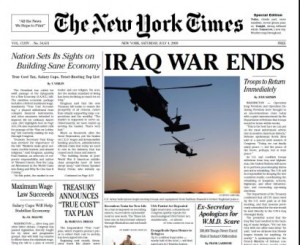The New York Times Special Edition

Steve Lambert (US) member of Because We Want It
http://nytimes-se.com/
Award of Distinction Hybrid Art
Installation and documentation
On November 12, 2008, one week after the election of Barack Obama, a special edition of “The New York Times” hit the streets announcing the end of the wars in Iraq and Afghanistan, a maximum wage, a new national public transit system and 14 more pages of “all the news we hope to print.” The paper was distributed throughout New York City as well as Boston, Los Angeles, San Francisco, other cities around the country, and on the website nytimes-se.com.
The project was a collaborative effort nine months in the making written by over 30 writers and distributed by hundreds of volunteers. When people were presented by this reality—it was literally put it into their hands in the form of the national paper of record—their critical faculties kicked into gear. Sadly, after seven years of ongoing war, truly imagining what peace could feel like is more difficult than one expects. The possibility of peace strikes one more powerfully because the paper makes the theoretical ideas and possibilities something one is actually holding in one’s hand, studying, and experiencing for a moment.
Inventor Dean Kamen once said that science already has solutions to all the world’s problems. There are incredibly informative studies buried in research journals and amazing but little known books that lay out step by step policies to solve global warming. Indeed, for many of the world’s problems, solutions do already exist. What we lack is vision and an articulated demand from an overwhelming majority of people. What the “NYT Special Edition” did was to explain this type of material in everyday language and as if it had already happened. A policy paper that was accessible, and, as Bill Moyers described it, “presented in a way that people would actually want to read.”
The response to the paper was overwhelmingly positive, reaching newspapers, magazines and television stations around the world. Readers seemed to understand that the paper, dated nine months in the future, was a vision; a plan for what was possible. A plan that doesn’t rely on powerful hero politicians to save the public, but a plan detailing the rewards of everyday people organizing together and pressuring, working, and demanding a more just world.
Supported by: Support from Eyebeam, Cultures of Resistance, The Electronic Frontier Foundation, CODEPINK, Wooster Collective, and others.
